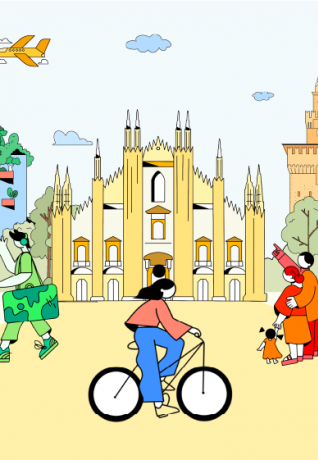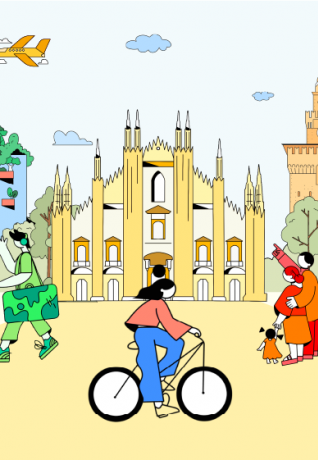Permits and Authorizations
Visa requirements for entering Italy vary based on citizenship

EU citizens enjoy the right of free movement within the Schengen area, while non-EU citizens typically need to obtain a visa from the Italian Consular Authority in their home country. However, depending on bilateral agreements, some non-EU citizens may be exempt from this requirement: mostly, for tourism or small business trips of less than 90 days.
To determine your specific situation, visit vistoperitalia.esteri.it and complete a self-assessment questionnaire. This tool considers your citizenship, place of residence, travel purpose, and duration to provide information on whether a visa is necessary. The website also outlines required documents and provides contacts of the nearest Consulate or visa center for application submission.
We strongly advise all European and non-European citizens to ensure they have all documents certifying their civil and family status translated and legalized into Italian before their arrival.
To secure employment in Italy, adherence to certain regulations is essential.
Most work visas are subject to an annual cap on the number of individuals for each productive sector that are allowed entry into the country, a figure determined by the government through an annual decree known as "decreto flussi". Additional decrees may be issued throughout the year to address varying workforce needs.
Some countries of origin, as well as some work sectors, are subject to special policies.
SUBORDINATE WORKERS: process to legally work in Milano
-
Find an employer who is willing to hire you. They can be either Italian or foreign citizens, but they must be resident in Italy. If they are non-EU citizens, they must possess a valid residence permit.
-
Your employer will apply for a clearance, known as "nulla osta", to hire you, a process facilitated through the Immigration Desk (Sportello Unico per l’Immigrazione).
The application can only be submitted online after the publication of the annual decree “Decreto Flussi”.
The decree sets the requirements for the application, including: minimum income of the employer; existence of accommodation for the foreign worker; draft for a residence agreement containing (work duties, hours, type of employment contract); commitment to pay for the return trip of the foreign citizen to the country of origin or provenance in the case of an expulsion order; declaration of the absence of reasons impeding the entry of the foreign worker,(e.g., of not having found an unemployed worker suitable for the same job in the province).
-
If 60 days pass since the application submission without any obstructive reasons emerging, the employer is informed and requests the nulla osta to be issued and sent electronically to the Italian diplomatic missions in the worker's country of origin. Notification of the nulla osta issuance is communicated to the employer via email.
The employer can directly download the nulla osta by accessing the Portale Servizi-ALI.
You will be able to submit the application for a visa for dependent work to the competent Consular office in your area. The diplomatic missions are required to issue the entry visa within 20 days of the corresponding application.
Upon obtaining the visa, you can enter Italy.
-
Notification of the nulla osta issuance is communicated to the employer via email. The employer can directly download the nulla osta by accessing the Portale Servizi-ALI. However, Police (Questura) and/or the National Labour Inspectorate (Ispettorato generale del lavoro) can make further checks anytime, and if they find something wrong, this will result in the revocation of the nulla osta and the visa. This entails the legal termination of the residence contract and the withdrawal of the residence permit.
SELF-EMPLOYED WORKERS: process to legally work in Milano
Like subordinate workers, self-employed workers are also subject to a quota set by decree (Decreto Flussi).
1. The request for a nulla osta is made in person at the Questura of Milano. If you are self-employed, you can schedule an appointment by writing to the dedicated email dipps146.00p0@pecps.poliziadistato.it.
N.B. The nulla osta office for self-employment accepts appointments on Tuesdays and Thursdays from 9:30 AM to 12:30 PM
2. At the time of requesting the nulla osta, the non-EU worker must possess documentation of the license or authorization for the intended activity.
Necessary documents:
-
Proof of suitable accommodation in Italy may be established by submitting either a property purchase or lease agreement or a declaration from an Italian citizen or a legally residing foreigner in Italy, verifying that they have offered appropriate lodging to the applicant or if you are staying in a hotel/B&B, the registration slip.
-
The applicant must show an annual income from lawful sources surpassing the minimum amount mandated by law for exemption from health care contributions (currently approximately €8,400)
WHAT HAPPENS IF THE QUOTAS PROVIDED BY THE FLOW DECREE ARE EXHAUSTED?
Applications submitted under the flow decree are reviewed in the order of their submission date. Due to the significantly limited available quotas in comparison to the number of applications, these quotas are typically exhausted rapidly.
When quotas are unavailable, authorization is not automatically granted. The DL 20/23 (currently undergoing conversion) has stipulated that applications rejected due to quota unavailability may be reconsidered, potentially prioritized, and subject to application renewal within the quotas anticipated to be made available through subsequent flow decrees.
The Blue Card enables highly skilled workers to work in Italy under a specific contractual arrangement (Article 27-quater, paragraph 1, letter a of Legislative Decree no. 286/1998).
In Italy, the Blue Card represents a work permit category that falls outside the annual quotas set by the Flow Decree. It is designed for foreign workers with advanced qualifications who have been offered the opportunity to work in Italy.
The regulation applies to foreigners residing in:
-
non-EU country
-
foreigners regularly residing in Italy (with some exceptions)
-
another EU Member State (They must have resided for at least 18 months in another EU country)
-
foreigners holding the Blue Card issued in another Member State.
WHAT IS MEANT BY A QUALIFIED WORKER?
To be eligible for the Blue Card in Italy, a worker must meet the criteria of being "highly qualified," which includes:
-
Holding a higher education degree (university diploma) indicating the successful completion of a higher education program lasting at least 3 years (bachelor’s degree).
-
Possessing a professional qualification falling within levels 1, 2, and 3 of the ISTAT classification of professions CP 2011 (ISTAT – Nomenclature and Classification of Professional Units).
-
For regulated professions, meeting the requirements for practicing the specific profession in Italy.
Foreign training certificates and other documents must be appropriately translated or legalized. This can be done either through Italian diplomatic representations in the countries of origin of the foreign workers or by Apostilles.
PRODCEDURE TO APPLY FOR THE BLUE CARD:
-
The employer submits the application for clearance for highly qualified workers to the Immigration Desk (Sportello Unico Immigrazione at Prefettura), which, in compliance with legal conditions, issues the clearance, allowing the interested party to obtain an entry visa for Italy;
-
To access the procedure, as indicated in Circular No. 5209 of the Ministry of the Interior dated August 3, 2012, it is necessary to register on the telematic application submission service on the website https://portaleservizi.dlci.interno.it, following the procedure;
-
After completing the registration phase, access the "Request Forms" area, where you can fill out the clearance request form for the issuance of the Blue Card EU (BC Form);
-
The procedure begins with the employer submitting the request for the nulla osta for the worker to the competent Immigration Desk (Sportello Unico dell’Immigrazione);
-
The nulla osta is replaced by a communication from the employer if the latter has signed a specific Memorandum of Understanding with the Ministry of the Interior.
Entry Visa and Exemptions:
No entry visa is required for Italy if the foreigner is already legally present in the national territory or holds a Blue Card UE issued by another Member State, having legally resided for at least 18 months. In the latter case, the employer must submit the work clearance application within one month of the entry of the highly qualified worker.
Within 8 working days of entering Italy, the international worker goes with the employer to the International Desk (Sportello Unico delll’immigrazione), which is responsible for signing the “Contratto di soggiorno” or in the case of family reunification.
Learn more about the Residence Permit

 Log in
Log in



